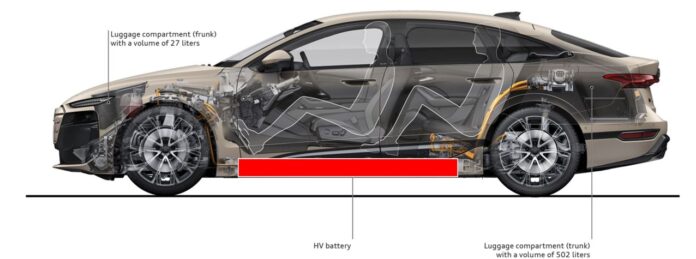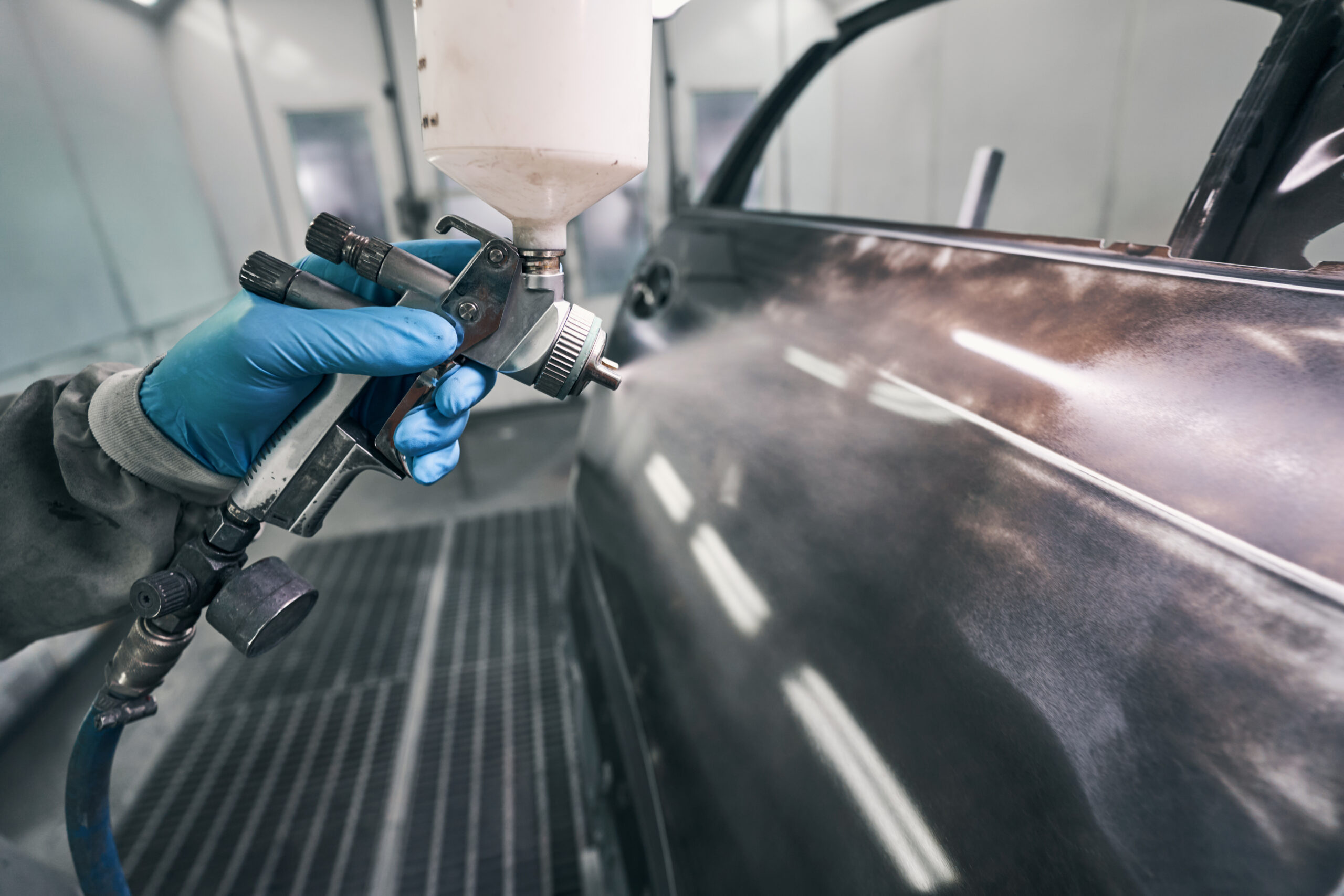Why BEVs are so immense?
Vehicle manufacturers rarely show a section through the vehicle, viewed from the side. Especially for a BEV…. Let’s look at ‘packaging’, and how that affect collision repair.
Internal combustion powertrains including electrification
Regardless of an engine driving the front wheel, the rear wheels or all wheels in most cases the engine and primary transmission are at the front of the vehicle. This means the powertrain has to fit between the front-end structure, and in the event of collision, is designed to move down as it is pushed into the passenger compartment to minimise or even eliminate intrusion.
The fuel tank will usually be located under the rear seat base, just about the least likely location for impact damage. In-between the front and rear the main services – exhaust system, AdBlue system for diesels, prop shaft for rear or all-wheel drive – are located in the tunnel which sits between the front seats, and passes under the rear seat. The tunnel not only provides a place for these systems but also contributes to distributing front or rear impact energy.
This layout allows the footwells – the main floor – to be located on or just above the ground clearance line. That line is defined as the front approach angle, the rear departure angle and a height below which nothing will hang below.
Looking at the upper structure, we can see an SUV by virtue of its height, can make the passenger compartment shorter. Conversely, the closer the roof line is to the ground, the passenger compartment elongates. This is primarily governed by occupant legs – sitting on a seat (an SUV) or sitting very nearly on the floor (a sports car).
To manage impact energy there are sacrificial structures at the front, side, roof and rear. The objective is to maintain the volume the occupants sit in – the safety cell- as the rest of the body absorbs and distributes the impact energy. The seats, seat belts and airbags provide occupant protection as the body does its work.
Adding to the mix
Additional sub-systems ranging from AdBlue to mild-, full- or plug-in hybrid, require space inside a packed vehicle. Each system will require cooling, heating, electric connection and interface with vehicle body controller. For older models still in production this has meant finding all sorts of unusual places for big assemblies.
Part of the consideration is the effect of a variety of impacts on system integrity. For example, we could find a place in the boot for a second Li-Ion battery, find ways to heat or cool it, counter the energy loss in reaching the engine bay, but should manage the fact the battery is in a crush zone.
Overall, the layout of the vehicle is still recognisably similar to a pure internal combustion engine powertrain and driveline, with many of the additional systems added to the front part of the powertrain or ahead of or above the rear suspension. Some vehicles add the mild hybrid system Li-Ion battery to the underside, or even inside the safety cell, under a seat.
So far, the logic is centred around managing the relatively large mass of the powertrain to ensure the body can still do its job and the powertrain does not punch through the safety cell. Side impact features significant reinforcement in the A pillar, B pillar, cant rail and sill – deflection is carefully calibrated in concert with side and curtain airbags to protect occupants. Further, transverse elements at the roof level and floor level help transfer energy across the bodyshell. In effect, the deceleration and management of impact energy over a relatively short distance relies on the occupants moving around in a very managed way, which is where the safety restraint system comes in to prevent inter occupant collisions.
The BEV belter
The opportunity for pure electric powertrains: The drive modules are inherently lighter and smaller than an internal combustion engine, although many manufacturers on smaller vehicles un-do this by stacking other items on top of the traction motor. The powertrain operates with simulated AC current, whereas the battery can only store DC current. So, the power controller does need to be located as close to the traction motor as possible to minimise power loss.
The more compact traction motor, if fitted to the front, eliminates so many package issues around mechanical drive to the steering rack, easier to make the traction motor push under the safety cell, and does not have diesel or petrol fuel lines to consider. For mass market BEVS a typical front end structure is much shorter than an internal combustion powertrain engine bay. Whereas we might find a chassis leg section on an internal combustion powertrain vehicle, such sections are less generous and, in some cases, don’t exist at all.
Now to the battery.
This is the biggest, most complex and heaviest part of a BEV. The sacrificial front and rear structures manage impact energy, but because Li-Ion batteries have around one fifth the energy storage density of petrol or diesel, and we are all still fixated on range due to patchy public recharging networks, the battery pox is extended out as close to the sills as possible. Indeed, the battery is so large the only place for it is under the whole of the passenger cell floor – the whole area between the front and rear wheels, and the sills.
Reaching for the heights
There’s more. The depth of the bod ranges from 50mm up to around 200mm.
So, maintaining the ground clearance line, the battery pushes the safety cell floor upwards. This is why the favourite body type for BEVs is the SUV, since it is easier to package. Taking the Tesla Model 3, a regular saloon, the only give-away is the width of the vehicle compared to similar body types (Audi A4, BMW 3 / 4 series, Mercedes-Benz C class). In other words, the battery pack needed a certain volume, it could not be made too deep, so had to cover a bigger area instead.
Bodyshells engineered for BEV powertrains have a flat main floor, although tunnels have started to appear on some designs – as a means to transfer impact energy longitudinally. As with the internal combustion powertrain bodyshells, transverse reinforcement at floor and roof level ensures side impact energy transfer.
The issue? The batter box sits so close to the sill it has to have separate crush elements to protect the modules, and hence the cells inside. Further, some battery packs include internal braces that allow impact energy acting on one side of the box to transfer to the opposite sill.
Due to the height of the battery pack, which has to contain a cooling system, the cells built up into modules, the battery control module and sometimes the charger as well – the floor is only just above the top part of the battery pack. Indeed, in the case of ‘structural’ packages, the top skin of the battery pack is what the seats, centre console and main floor carpet are fitted to.
Because the internal combustion powertrain bodyshell is self-supporting, removal of the entire interior does not prevent somebody going inside to do repair work. In the case of a BEV, care should be taken to note…. Some manufacturers warn nobody can go inside the bodyshell if the traction battery is removed.
To counter this some manufacturers not only have UHS steel alloy transverse braces, but also the floor itself made from UHS steel alloy.
As always, it’s vital to do the homework before starting a repair. We must not add to the damage caused by the impact.




